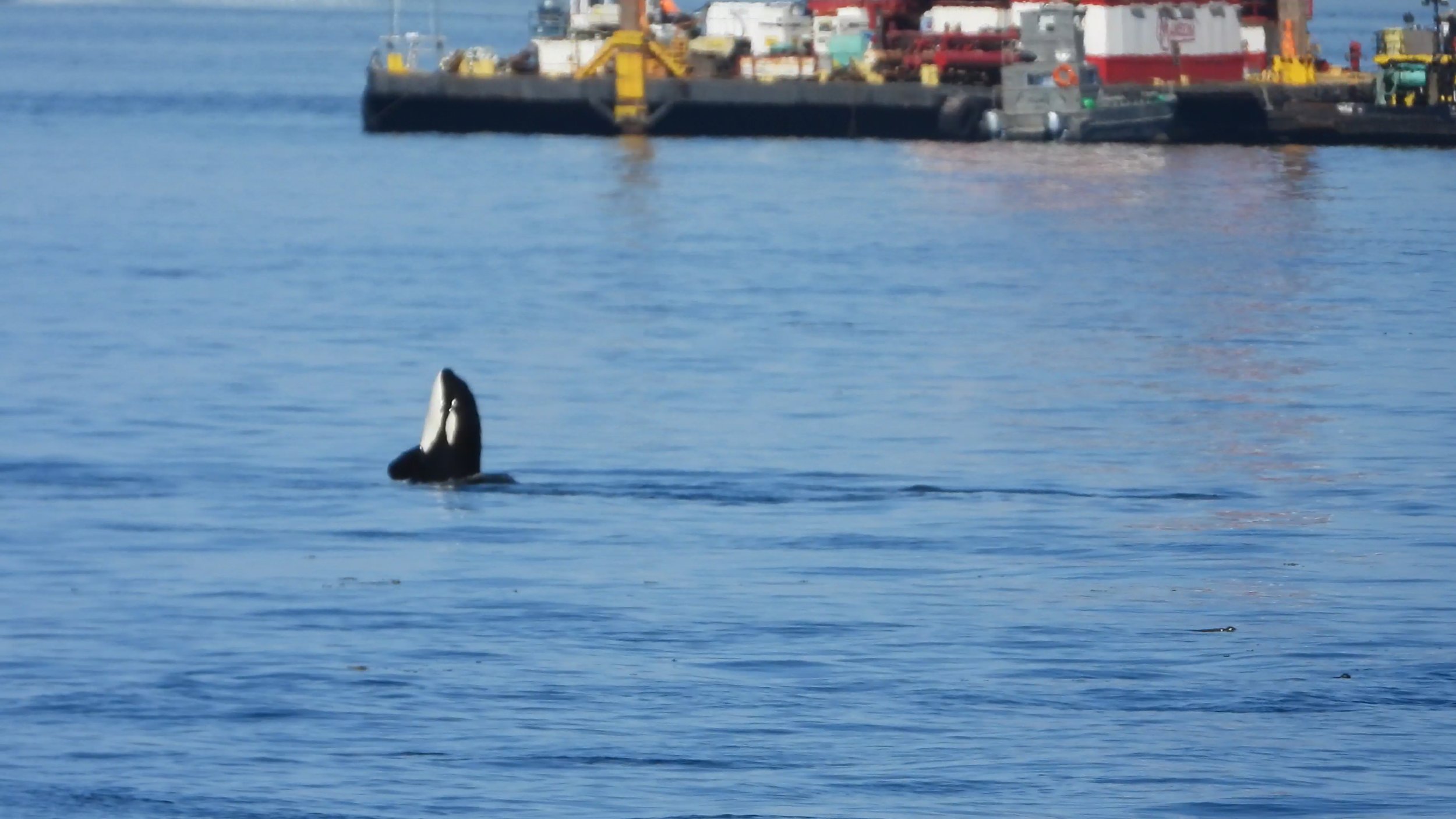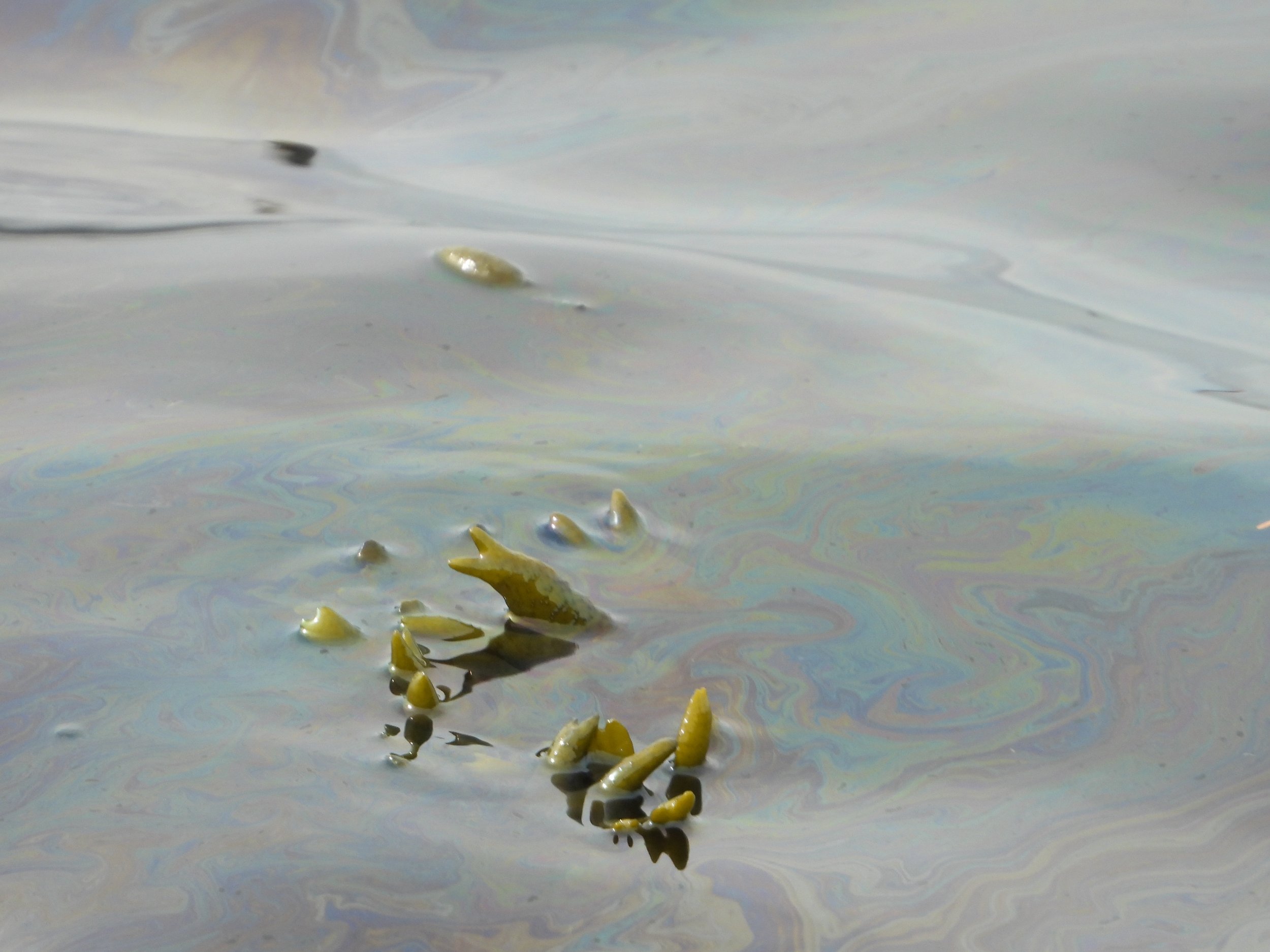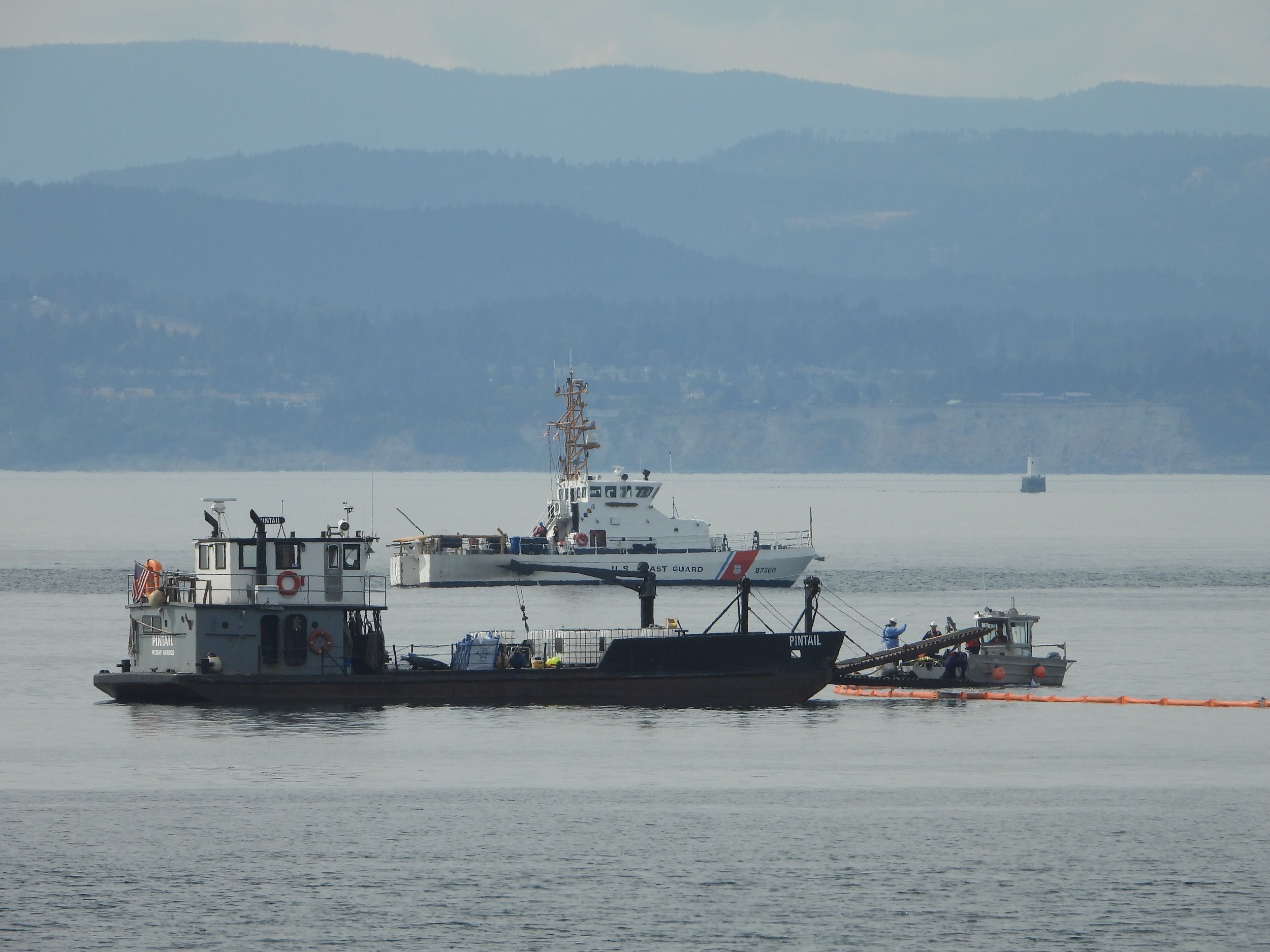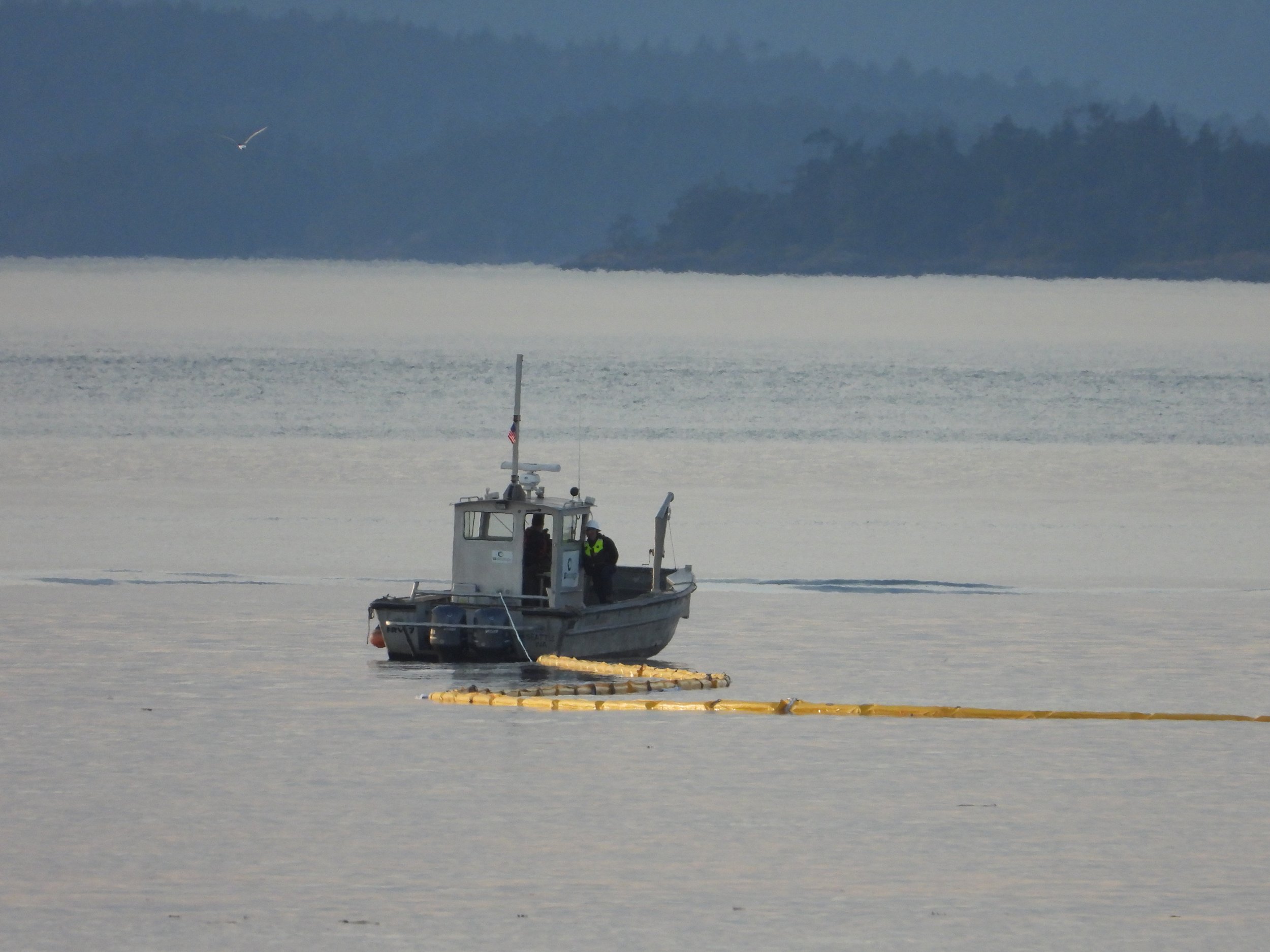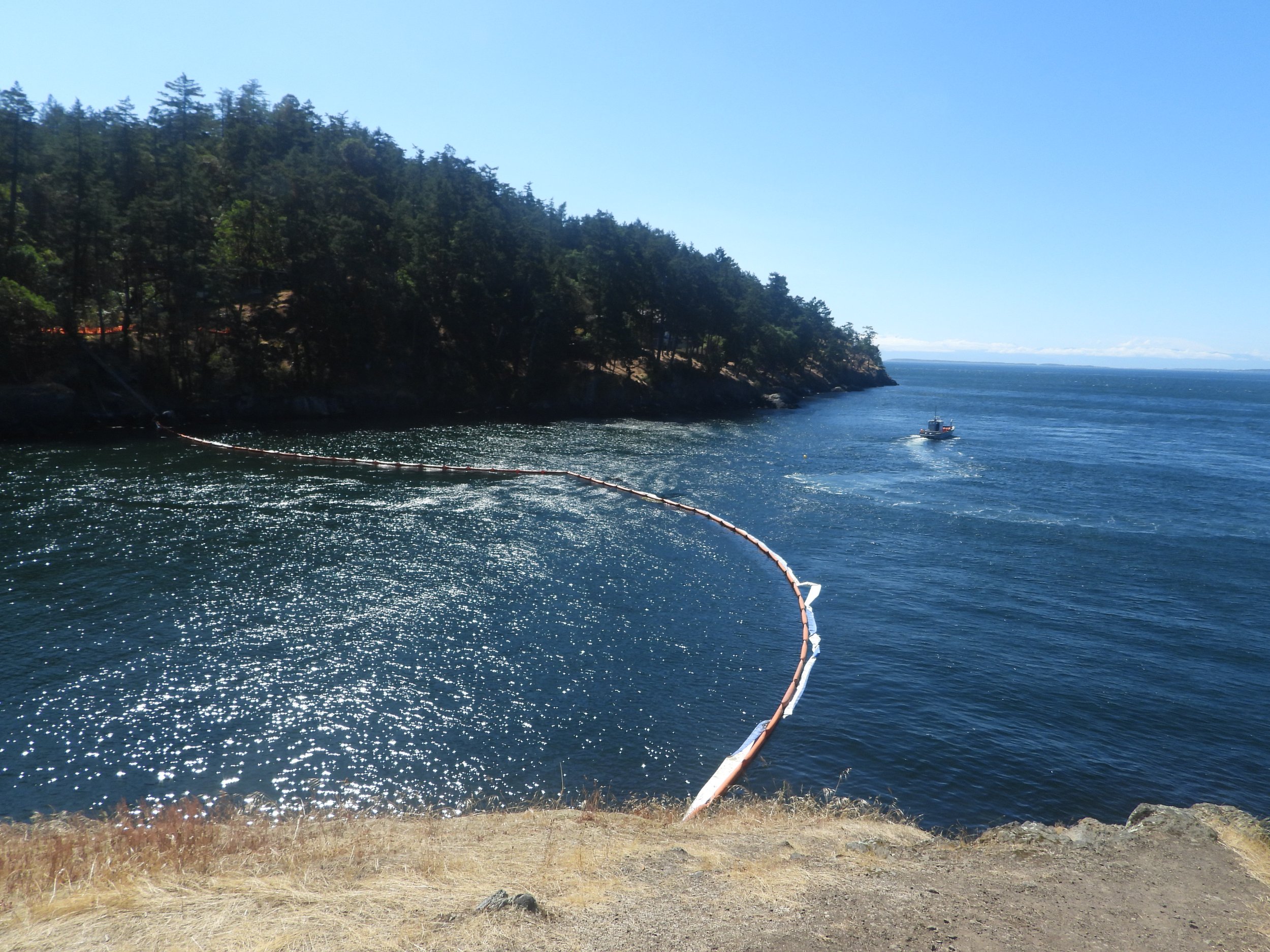Oil Spill Preparedness and What We Can Learn from Barnes Lake and Other Incidents
Response teams deploying a hukilau behind T49A2 & T51 (Photo taken by David Bain under NOAA MMHSRP Permit #24359)
The Threat of an Oil Spill:
J Pod surfacing off the west side of San Juan Island
The Southern Resident killer whales (SRKWs) are a critically endangered population with only 75 individuals remaining. This population faces threats of lack of food, boat noise, and pollution. But these aren’t the only risks to a struggling population, there is also the increasing threat of oil spills or pollution events, which could devastate the population.
With the approval of projects such as the Roberts Bank Terminal 2 expansion project, and the near-final Trans Mountain Pipeline, vessel traffic and oil export will significantly increase the risk of a spill in critical habitat for the SRKWs.
Over the course of the past decade, state and federal agencies have been working to improve oil spill response plans and preparedness to mitigate any risks to the endangered SRKWs as well as other populations like the mammal-eating Bigg’s or transient killer whales and other species.
Orca Conservancy is a registered organization to assist in an oil spill response if needed, and early in October members from Orca Conservancy attended the Oiled Wildlife HAZWOPER training hosted by the Washington Department of Ecology.
At the training, we spent some time with colleagues who were interested in feedback and learnings from the techniques deployed in freeing the orcas stranded in Barnes Lake, and whether some of these tactics could be utilized in a spill response.
Barnes Lake Stranding:
At the end of September, Orca Conservancy along with NOAA Fisheries Alaska Region, Fisheries and Oceans Canada (DFO), and the community of Coffman Cove, Alaska, were successful in freeing two transient/Bigg’s killer whales (mammal eaters) who had been trapped in Barnes Lake for six weeks.
T490A2 & T051 in Barnes Lake (Photo taken by Chloe Kotik under NOAA MMHSRP Permit #24359)
The teams identified three main tactics to use to get the whales out of the lake and include:
Acoustic recordings or playbacks of whales known to associate with the whales
Hukilau, a Hawaiian fishing apparatus that utilizes long lines and floats deployed between multiple vessels
Oikomi Pipes, hollow metal pipes that create an acoustic disturbance when struck
Ultimately what ended up working was a lead boat playing the acoustic recordings, luring the whales into the channel, while boats behind the whales deployed a hukilau after they entered the channel. The boat with the acoustics would drop the speaker into the water and play roughly three seconds of calls, before bringing it back up and traveling further into the channel. The whales showed no hesitation following the playbacks and were successfully guided back out into the ocean.
Recent Spill Response:
One of the major challenges when planning a spill response and hazing practices with wildlife is that responders don’t usually get the opportunity to test the execution or success of a tactic ahead of time. This was especially the case during the sinking of the Aleutian Isle in critical SRKW habitat during the summer of 2022.
The Aleutian Isle suspended by a crane in Haro Strait
The sinking of the Aleutian Isle, a 49-foot fishing vessel, off the west side of San Juan Island, caused a small-size diesel fuel spill. On the same day, reports of all three SRKW pods had been reported as traveling east towards San Juan Island. Luckily, the whales never made it to the spill before heading back out west to the ocean, but their presence called into question the response and the level of preparedness to detour or haze wildlife from approaching dangerous pollutants.
While multiple agencies including members from Orca Conservancy (who happened to be on-site overnight), were monitoring for whales, there was little or nothing that could be done at that time to detour the whales from entering the spill had they traveled through it. The Coast Guard Cutter Swordfish that remained on site with the wreck was supplied an oikomi pipe, but with only one pipe, it was doubtful this would have succeeded as a deterrent.
Assembling hazing teams, as well as stocking oikomi pipes on hazing vessels, and training teams on how to use the pipes took place after the initial spill. The teams were also not able to test the effectiveness of the hazing methods ahead of an actual hazing response, making it unclear whether or not the methods would work.
During the retrieval and raising of the Aleutian Isle, pollutants leaked into the water. Several days after the lifting of the shipwreck, possible contaminants could have still been leaking in the water, prompting hazing teams to be on call in the event of whales entering the site. The team was called in to haze a matriline of transient killer whales using oikomi pipes, but the teams had reported back that the efforts were not successful as the whales deep dove below the pipes.
What Can We Learn
While the Aleutian Isle response required teams to work on the fly and test hazing responses during the actual spill, the incident in Barnes Lake offered teams the opportunity to test different strategies and techniques without the risk of pollution, which may help provide learnings, strategies, and even experience that could be useful in the event of a spill.
Barnes Lake Response Team with Oikomi Pipes (Photo by Kathy Peaves taken under NOAA MMHSRP Permit #24359)
Some feedback both incidents, as well as other events, have taught us about oikomi pipes is that their effectiveness may vary based on location and ecotypes. In 1994, a pod of offshore killer whales were entrapped in Barnes Lake, and oikomi pipes were used successfully to maneuver whales out of the north channel. While this tactic worked for offshores in a lake, it was not successful with Bigg’s in Haro Strait, which is a much larger body of water with deep depths, allowing the whales the opportunity to easily maneuver away from noise disturbances. It is also possible that transients may be less sensitive to noise disturbances the way offshores or potentially Resident whales might be since this ecotype relies less on echolocation and more on eyesight and passive listening to find prey.
Solutions around oikomi pipes and depth, are to record the sounds of oikomi pipes that can be played on underwater speakers. The underwater speakers would allow responders to play sounds at a variety of depths that a metal pipe could not reach, but it would also allow responders to control the volume.
Playbacks proved to be successful in luring the two transients out of Barnes Lake in September, but there are a lot of questions about the effectiveness of luring whole matrilines or pods away from something in the event of a spill. The risk of playbacks for luring could also cause confusion amongst the whales.
While playbacks of familiar calls may not be ideal for an oil spill response, there is the possibility that playing calls of different ecotypes could work as a deterrent. This technique was not tested in Barnes Lake, but other researchers have observed that specific ecotypes, such as Bigg’s adamantly avoid other ecotypes, especially Northern Residents. Researchers wonder if playing Northern Resident calls would be a more effective way to detour transients from a spill than oikomi pipes.
The speakers and boat rigging used for the playbacks of the Barnes Lake response can also offer a blueprint to response agencies to get all the required equipment ahead of time to keep on hand and deploy on hazing boats if needed.
The Barnes Lake teams were also able to assemble and deploy the hukilau behind the whales as they entered the channel, to serve as a visual barrier to prevent the whales from turning back. This is another option that could be used depending on the location and depth of a spill site. In theory if a spill was in a shallow bay or channel, a hukilau along with booms could be used to absorb pollutants and also keep marine mammals out of an area.
If there’s anything that we can know for sure, is that one tactic or technique may be successful in one event, but ineffective in the next. Each response, whether it is a stranding or an oil spill can vary drastically, with each location or time of year offering a variety of variables that will impact a response. Having the supplies, trained response teams, and a plan ahead of time can increase the effectiveness and the ability to respond. Time is critical in any response, so having resources ahead of time could make a significant difference in the ability to protect wildlife, including the endangered Southern Residents.
Follow us on social



